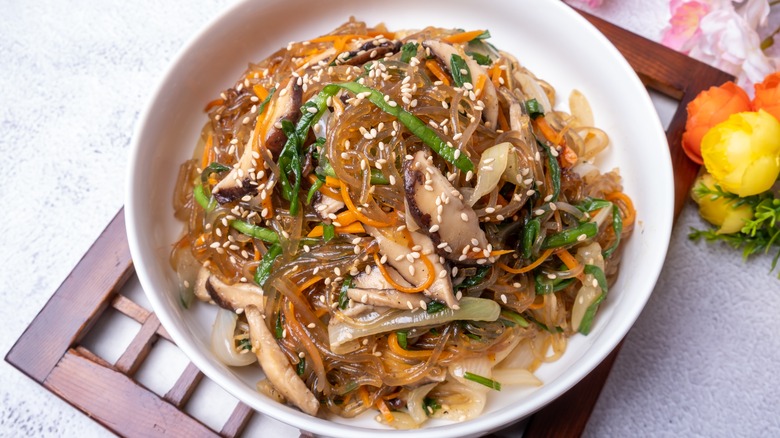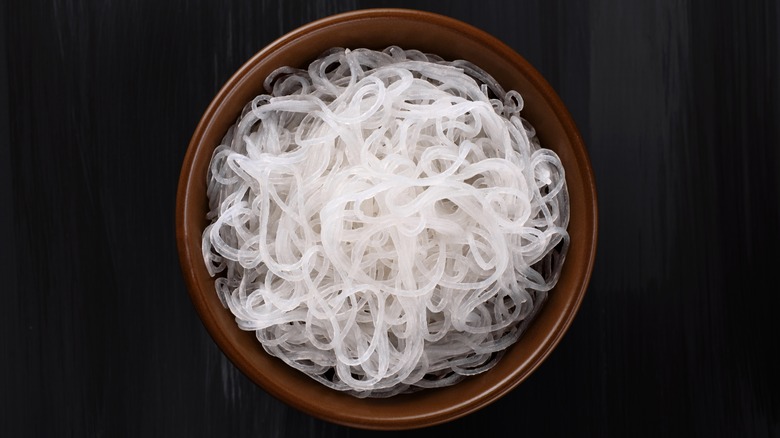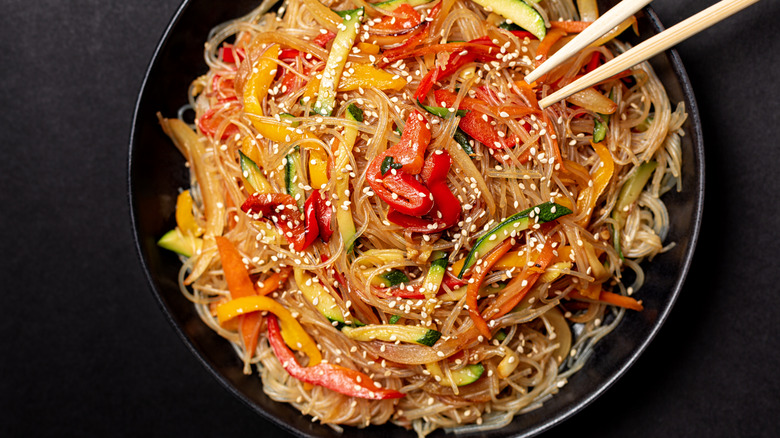Chinese Vs Korean Glass Noodles: What's The Difference?
Glass noodles may sound like a delicate delicacy, but these starchy noodles are a common presence throughout Asian cuisine. Also known as cellophane noodles, glass noodles are characterized by their eponymous see-through appearance, which is further enhanced through the process of cooking them. Of the types of glass noodles, Chinese and Korean glass noodles are among the most prevalent and can be found in many popular dishes.
There's one major difference between Chinese glass noodles and Korean glass noodles, but the key similarities are clear to see: Both boast a chewy texture and adaptably delicious flavor that conjures up a feeling that can best be described as comfort food. The biggest difference between these two transparent noodles is largely each noodle type's respective composition in terms of starch, which is based on the availability of ingredients and the dishes in which each of these types of noodles is typically included.
What are Chinese glass noodles?
Chinese glass noodles are commonly known as fen si (or fensi), bean threads, or bean thread noodles and are among the essential ingredients used in Chinese cooking. These names all reflect both the ingredients and consistency of the noodles themselves, with mung bean starch being the main dry element, and the shape of the noodles resembling threads. Made by working a mixture of mung bean starch and water through pulling and stretching, the noodle base is eventually pushed through a fine strainer to create thread-like shapes, which are then left to dry.
The fineness of these noodles lends itself to optimal absorption of liquids, adapting to the flavors added in cooking. This makes them an excellent ingredient to include as a filling for egg rolls or in a Chinese dry pot meal. Additionally, Chinese glass noodles are ideal for use in a stir-fry to take on the flavors of the proteins and vegetables, such as in a vegetable stir-fry or a more protein-packed winter chicken and vegetable stir-fry. Truly, the biggest difference between Chinese and Korean glass noodles comes down to the type of starch with which each one is made. While both have a similarly chewy texture, there is a subtle difference in the clarity and flavor of the mung bean base starch of Chinese glass noodles than that of Korean glass noodles.
What are Korean glass noodles?
Korean glass noodles are similar to Chinese glass noodles in terms of the method of preparation, texture, and consistency. However the biggest difference is that they are typically made using the starch from sweet potatoes. They are referred to as "dangmyeon" and differ slightly in taste from Chinese glass noodles. Dangmyeon are one of the essential ingredients for Korean cooking, with the stir-fry noodle dish called Japchae among the most common uses for them.
Japchae is also a staple dish made in celebration of the Korean Lunar New Year. Though usually made with meat, Japchae can also be adapted into a plant-based version with mushrooms and vegetables. As with Chinese glass noodles, Korean glass noodles also require a pre-hydration stage prior to cooking to ensure pliability and evenness in cooking regardless of the dish in which they are used. The thin and flavor-absorbing capabilities of Korean glass noodles also mirror that of Chinese glass noodles, making the two relatively similar save for key starch distinction.


